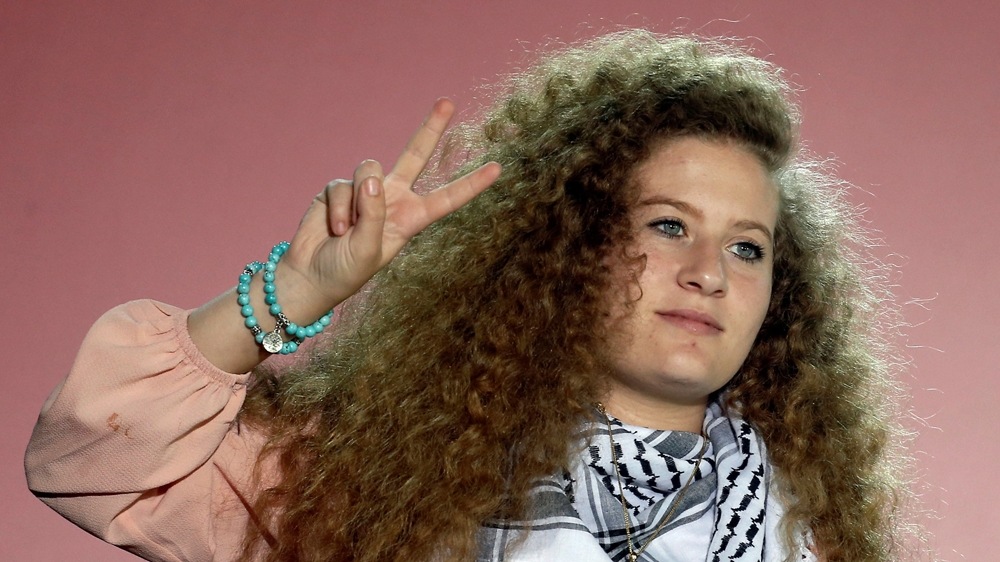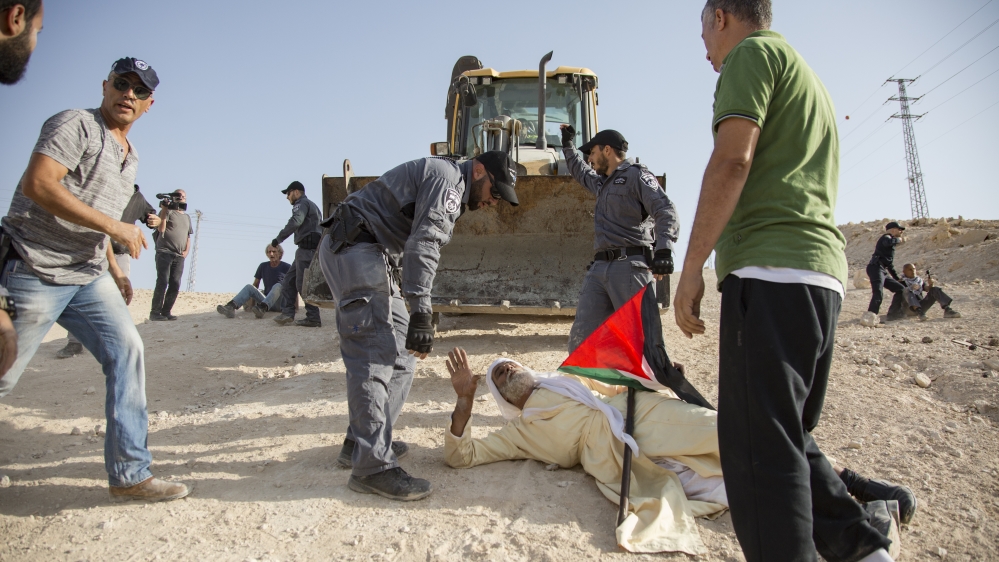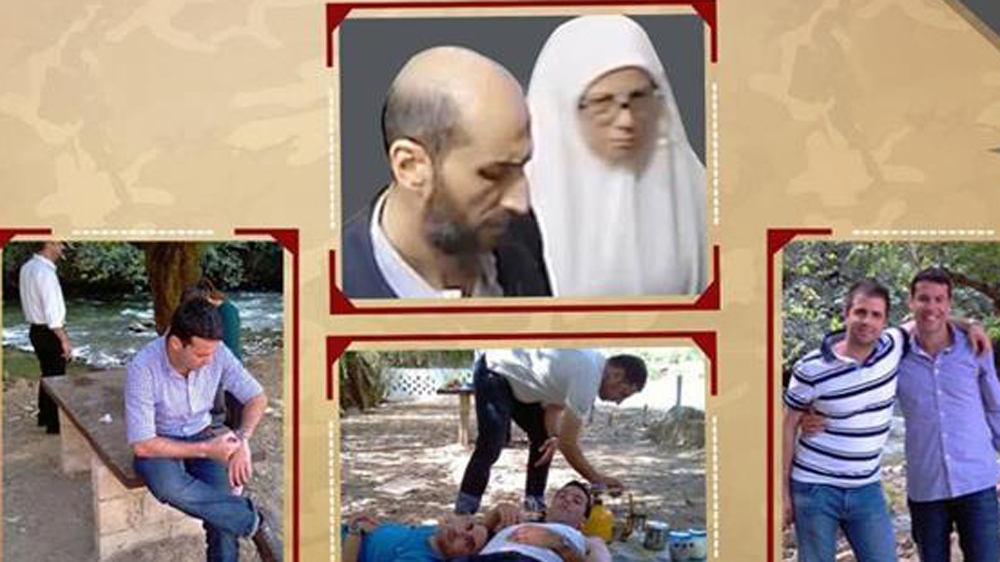The events that shook the Palestinian territories in 2018
 |
| AL JAZEERA NEWS 31 Dec 2018 |
With little reason for optimism for 2019, here are the main events that rocked the West Bank, Gaza and Israel this year.
Over the past year, Palestinians have experienced no respite from the Israeli occupation, let alone a breakthrough of ending it. Although no full-scale war broke out in 2018, as some had expected, it did bring a grim year of deadly violence, illegal settlement expansion and home demolitions.
At least 289 Palestinians – men, women and children – were killed throughout 2018, while thousands of others were wounded, including many who were maimed for life by Israeli gunfire. According to the Defense for Children organisation, the death toll includes 56 Palestinian children – an average of more than one child every week.
At least 538 housing units and facilities were demolished in the occupied West Bank, resulting in 1,300 Palestinians losing their homes, a report by the Palestinian Liberation Organisation’s Centre for Studies and Documentation said.
Meanwhile, the Israeli-Egyptian blockade on Gaza is still ongoing, which the United Nations has repeatedly warned is having a devastating effect on the strip’s two million population.
On an internal level, the national reconciliation talks between rival governments of Hamas and Fatah, who control the Gaza Strip and pockets of the West Bank respectively, have made precious little progress. The division in Palestinian politics continued for the 11th year running, as the main deadlock remains centred on allowing the Palestinian Authority full control over security forces in the Gaza Strip, including the military wing of Hamas.
A number of jarring decisions made by the United States, such as moving its embassyfrom Tel Aviv to Jerusalem, finally convinced the Palestinian leadership of the US’ bias in the conflict. President Donald Trump has also declared an end to the funding of the main UN refugee agency for Palestinians, putting five million refugees in the occupied territories and neighbouring countries such as Jordan, Syria, Lebanon and Egypt, at risk of not receiving food aid, education, vocational training, jobs and much more.
Here is a recap of the main events that shook the Palestinian territories in 2018:
Ahmad Jarar – February 6
The violence in 2018 began with a Palestinian shooting dead a Jewish settler on January 9 near the occupied West Bank city of Nablus. The shooter fled the scene, which prompted Israeli forces to go on a manhunt that lasted almost one month.
On February 6, Israeli soldiers assassinated Ahmad Jarrar. The 22-year-old was killed in a shoot-out from his hiding place in the village of Yamoun, some nine kilometres from his hometown of Jenin. His body was taken by Israel forces, who have a policy of seizing bodies – a practice condemned by international law.
The pursuit of Jarrar resulted in almost daily raids of various towns and villages in the West Bank. Three homes belonging to the Jarrar family were demolished, and two Palestinians, including Jarrar’s cousin Ahmad Ismail Jarrar, were killed in separate raids.
Residents reported that the Israeli forces used loudspeakers to call out, “Ahmad Jarrar, turn yourself in or we will demolish the village house by house.”
Gaza’s Great March of Return protests – March 30
On March 30, Palestinians from all backgrounds staged the first weekly Friday protest near the Israeli fence, east of the Gaza Strip. Demonstrators have been calling for the right of return for Palestinian refugees to their lands (under UN Resolution 194) and are demanding an end to the 12-year Israeli blockade.
Asad Abu Sharekh, spokesperson for the campaign, told Al Jazeera that the march is meant to send a message to the international community to actively support the right of Palestinians to return to their lands.
According to health officials in Gaza, to date, Israeli forces have killed at least 220 Palestinians in the besieged coastal enclave and wounded more than 18,000 people.

“Great March of Return” demonstrations have continued in Gaza every Friday since March 30
About 80 percent of the Gaza population is dependent on humanitarian assistance, while the strip experiences regular power outages and high unemployment. It has been dubbed as the world’s largest open-air prison, with Palestinians needing Israeli army permits to enter and exit the enclave.
US embassy move to Jerusalem – May 14
The Trump administration delivered on its promise to move the US embassy from Tel Aviv to Jerusalem, ignoring worldwide condemnation and protests from outraged Palestinians.
The ceremony was attended by Trump’s daughter Ivanka and her husband, Jared Kushner, who also serves as a senior adviser to Trump.

Senior White House Adviser Ivanka Trump and US Treasury Secretary Steven Mnuchin opened the new US embassy during the dedication ceremony in Jerusalem on May 14 [Ronen Zvulun/Reuters]
Many of Jerusalem’s Palestinian areas were shut down on the day, with an increased presence of Israeli police on the streets. The closures spread to occupied East Jerusalem, where access to the Old City was curtailed in areas leading to it such as al-Tur, Mount of Olives, Sheikh Jarrah and Silwan.
Yet, Israel’s bloody response took place in the Gaza Strip during Palestinian protests near the fence, where 61 protesters were shot dead.
More than 2,400 others were also wounded as the Israeli army fired live ammunition, tear gas and firebombs at protesters assembled along several points near the fence with Israel.
70th anniversary of the Nakba – May 15
Palestinians commemorated 70 years since the Nakba, or “catastrophe”, which is defined as the removal of 750,000 of the population from historical Palestine in 1948. Paramilitary Zionist groups seized or destroyed some 500 Palestinian villages and towns in the process, and have barred the resultant refugees from returning ever since.
Protests took place in smaller Palestinian towns and villages, while the cities such as Ramallah and Bethlehem went on strike for the day, protesting against the killing of Palestinians in Gaza the day before.
Israel’s nation-state law – July 19
The Israeli parliament, the Knesset, adopted the controversial legislation that defined Israel as “the historical homeland of the Jewish people and they have an exclusive right to national self-determination in it”.
The bill makes Hebrew the country’s national language and defines the establishment of Jewish communities as being in the national interest. It further marginalises the 1.8 million Palestinian citizens of Israel, who now have more than 65 Israeli laws that discriminate against them.
It also states that an undivided Jerusalem is the capital of Israel, and strips Arabic of its designation as an official language, downgrading it to a “special status”.
Ahed Tamimi freed from jail – July 29
Ahed Tamimi made international headlines when she was arrested in a pre-dawn raid on her home by Israeli forces in her village of Nabi Saleh, known for its weekly popular protests against the Israeli occupation.
The then 16-year-old was arrested by Israeli forces in December 2017 after a video went viral showing the teenager slapping two armed Israeli soldiers outside her home.

Palestinian teenager Ahed Tamimi gave a speech at the annual festival of Greek Communist Youth in Athens, Greece, on September 22 [Costas Baltas/Reuters]
At the time, the teen was reacting to news that her 15-year-old cousin Mohammed had been shot in the face by Israeli forces with a rubber-coated steel bullet earlier in the day, leaving him in critical condition.
Tamimi was sentenced to eight months in prison. Her arrest drew international condemnation and again put the spotlight on Israel’s treatment of Palestinians, especially Palestinian youth.
US UNRWA cuts – August 31
The US government, a major ally of Israel, announced it was stopping its funding to the UN Relief Works and Agency (UNRWA) after determining the organisation to be an “irredeemably flawed operation”.
UNRWA was established in 1949 after 700,000 Palestinians were forcibly displaced from their homes by Zionist paramilitaries in the run-up to the establishment of the state of Israel.

Palestinian children protested against the UNWRA decision to dismiss personnel in Gaza City on September 25 [Reuters]
It currently provides services to five million Palestinian refugees in the occupied West Bank and Gaza Strip, as well as Jordan, Lebanon and Syria.
Demolition of Khan al-Ahmar village on hold – October 23
Khan al-Ahmar, located northeast of occupied East Jerusalem, has been under threat of demolition for several years.
But in September, the Israeli high court ruled that the Bedouin village, home to 180 people, will be demolished on October 1 under the pretext that it had been built without a permit.
However, three weeks later, the Israeli government announced it was putting the demolition on hold for a “short, fixed period of time”.

People staged demonstrations in support of the Al-Khan Al-Ahmar Bedouin hamlet, which is at the risk of demolition by Israeli authorities [AP]
The village’s location between two major Israeli settlements, Maale Adumim and Kfar Adumim, has been a thorn in the side of the Israeli government, which wants to expand the two in order to build a ring of settlements around East Jerusalem.
Khan al-Ahmar is in Area C of the occupied West Bank, which is under full Israeli control. In order to build anything, Palestinians living in the area need a permit that is rarely issued by Israeli authorities.
Netanyahu official visit to Oman – October 25
Marking what was the first visit by an Israeli leader to the sultanate in over two decades, Netanyahu‘s office said the visit came at the invitation of Sultan Qaboos and followed “lengthy contacts between the two countries”.
His office added that it formed part of a policy of “deepening relations with the states of the region”.
Oman and Israel do not have diplomatic relations. The visit was expected to increase pressure on Palestine to participate in US-led peace negotiations.

Netanyahu visited Sultan Qaboos bin Said in Oman [Israel GPO/Handout via Reuters]
The last Israeli prime minister to visit Oman was Shimon Peres in 1996.
On October 29, Israeli Sports and Culture Minister Miri Regev’s official visit to the Sheikh Zayed Grand Mosque in Abu Dhabi was seen by Palestinians as further proof that Arab countries were being swayed by Israel’s bid for normalisation.
A day before, Regev was present when the Israeli anthem was played for the first time in the UAE after an Israeli athlete won the gold medal in the Judo Grand Competition in Abu Dhabi.
Israel’s botched undercover operation in Gaza Strip – November 11
An Israeli covert operations unit infiltrated the Gaza Strip and had their cover blown, resulting in the killing of seven Palestinians and one Israeli soldier.
Nour Baraka, a senior commander of the Qassam Brigades, was among those killed, as Israeli forces pounded the Khan Younis area with air raids to give the unit cover to escape back into Israel using a civilian car.

Hamas published photos of what it says are members of an Israeli covert operations unit that infiltrated the Gaza Strip on November 11
By November 13, seven more Palestinians were killed by Israeli air raids, which had targeted a number of residential and government-owned buildings such as the offices of the al-Aqsa television channel.
The latest round of fighting, which had raised fears of a fourth Israeli offensive on the strip since 2008, ended on the same day after Egypt brokered a ceasefire, leading Avigdor Lieberman, Israel’s defence minister, to resign in protest.
Ramallah lockdown – December 13
Following a night where Israel killed three Palestinians in separate raids in the occupied West Bank, an unknown Palestinian shooter killed two Israeli soldiers near the illegal settlement of Ofra before fleeing the scene.
This prompted the Israeli army to declare Ramallah a closed military zone, and carry out searches near areas of roads entering and exiting the city.

Israeli security forces and emergency personnel at the scene of a shooting attack near the Israeli settlement of Ofra in the occupied West Bank [Ammar Awad/Reuters]
A fourth Palestinian was also killed after what Israeli forces said was a car-ramming attempt. Palestinian witnesses, however, said Ardah lost control of his vehicle.
According to the Palestinian Red Crescent, 69 Palestinians were injured in protests against the Israeli army raids into Ramallah and various other towns and villages in the West Bank.
Looking ahead
There is little reason for optimism about the prospects for 2019. The new year looks to offer more in terms of stagnation in the Middle East peace process, as well as the national reconciliation between Fatah and Hamas.
With the Trump administration firmly backing Israel on the international stage, and tacitly approving illegal settlement construction in the occupied West Bank, Palestinians will continue to regard the US as an impossible broker of peace talks.
Furthermore, the so-called “deal of the century”, reportedly pushed for by Trump’s son-in-law Kushner, in all its ambiguity and what has been leaked to the media, has failed to win the approval of the Palestinian leadership.
On April 9, Israel will hold snap elections, for which Netanyahu called on Israeli voters to give the government a clear mandate to continue governing on its current path. However, the prime minister will first have to fend off prosecutors who are after him and his wife in a criminal case relating to receiving funds from wealthy benefactors.
On a domestic level, the unity talks between Fatah and Hamas are unlikely to witness a breakthrough.
On December 22, Palestinian Authority President Mahmoud Abbas declared his intention to dissolve the largely defunct Palestinian parliament, the Palestinian Legislative Council, where Hamas holds a majority. Abbas, citing a Constitutional Court order, also announced that general elections would be held within six months of the PLC being dissolved.
The PLC has not held an official session since 2007, when Hamas seized control of the Gaza Strip. The movement rejected Abbas’ decision as an “invalid political decision”.
There also seems little intent to lift the Israeli-Egyptian blockade on Gaza, and the Israeli military presence shows no sign of abating in the West Bank. On a political level, optimism remains as elusive as ever.


